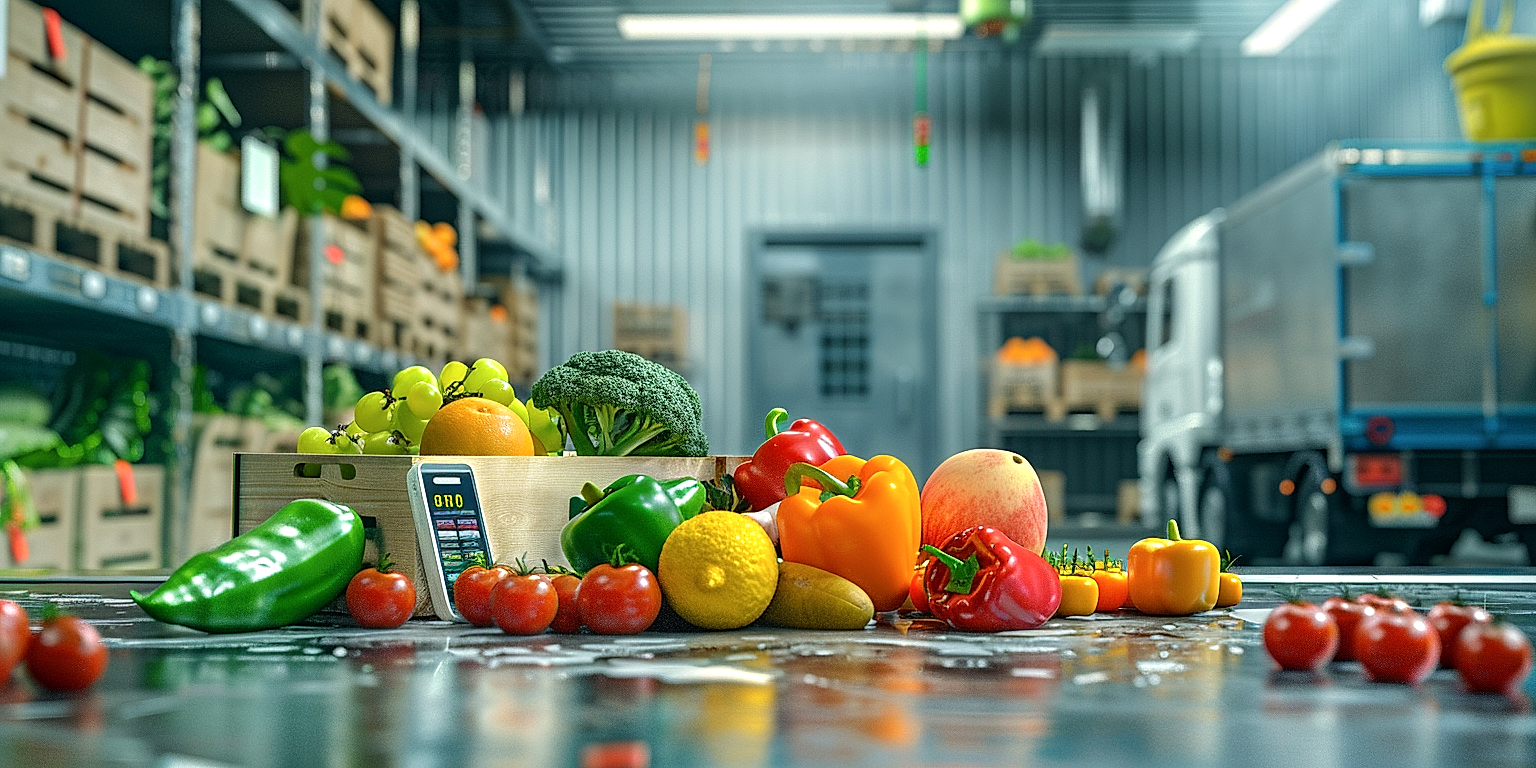Global trends point towards an increasingly competitive agrifood landscape.
At the heart of these trends are spiraling logistics costs for shipping produce, particularly challenges tied to fuel inefficiency.
The vast amounts of required energy for the cold storage, speedy transportation, and long-distance shipment of produce is becoming an increasing pain point for the industry.
Addressing these challenges requires shippers to adapt robust strategies to enhance fuel efficiency.
Progressive advancements in technology and innovative practices are reshaping the sector, enabling companies to explore smarter and more sustainable ways to ship.
This article sheds light on key strategies to minimize fuel usage, reduce costs and make the produce shipping industry more sustainable and efficient.
Contents
Ways To Optimize Fuel Usage In Produce Shipping
1. Implement efficient route planning strategies
In the realm of produce shipping, optimizing fuel usage is a fundamental aspect toward reducing operational costs and promoting environmental sustainability.
To achieve this, the implementation of efficient route planning strategies is invaluable.
Today, staying competitive in the transport sector necessitates precision in execution and conserving resources, therefore, every route traveled must be optimized to consume the least fuel possible.
This encompasses, fore mostly, planning effectively to minimize the distance travelled and avoid unnecessary detours or congested areas that may increase idling time and thus fuel consumption.
The strategy also leverages knowledge of the delivery areas and synchronizing scheduled pickups and drop-offs to limit empty miles.
Therefore, combining deliveries simplifies logistics, decreases the time taken on the road, and ultimately conserves fuel.
Besides, efficient route planning benefits from the use of real-time traffic updates, and data analytics that account for various factors like delivery windows, rush hours, and road works to find the most economical route.
This also works in anticipation of unforeseen situations by having pre-defined alternative routes that help keep traffic moving and minimize time wasted idling or in stop-and-go conditions, both of which are significant drain on fuel.
Moreover, driving behavior also has a significant impact on fuel usage.
In this light, drivers should be trained to adopt efficient driving practices like gradual acceleration and smooth deceleration, as aggressive driving burns more fuel.
Moreover, drivers should be advised to maintain constant speeds where possible, as variable speed also increases fuel consumption.
While on-route, efficiency can also be enhanced by limiting stop times at delivery points and optimizing loading and unloading activities to reduce the engine’s idle time.
Equally important, it is imperative to review and adjust routes regularly due to changes in infrastructure or in the company’s delivery requirements.
Additionally, advances in technology provide sophisticated tools like GPS and fleet management software that aid in developing and implementing efficient route strategies.
These tools provide real-time data and auto-corrective responses to evolving conditions on the ground, ensuring the most time and fuel-efficient routes are always taken.
2. Use Aerodynamic Trailers for Transportation
One of the highly effective strategies for optimizing fuel usage in produce shipping is through the use of aerodynamics trailers.
These trailers are scientifically designed to minimize air flow disruption, reducing the amount of energy needed to move the trailer forward.
Aerodynamic trailers essentially function by reducing drag, thus improving fuel efficiency.
By minimizing resistance against the trailer as it moves, aerodynamic designs allow the vehicle to consume less fuel, significantly saving on energy costs in the long-run.
These streamlined designs don’t just benefit fuel usage; they also contribute to the reduction of greenhouse gas emissions.
Fuel savings from aerodynamics can significantly reduce a fleet’s carbon footprint, a pressing concern with the increasing urgency to address climate change.
Moreover, with the growing trend towards sustainable and eco-friendly business practices, switching to aerodynamic trailers can also add value to your brand’s image.
Investing in aerodynamic trailers might seem costly initially, but the returns from fuel savings, reduced maintenance costs, and potential tax benefits offset the upfront investment.
Several providers in the transport industry already offer aerodynamic solutions designed to improve transport efficiency.
These solutions range from simple add-ons to more complex modifications, giving transporters numerous options to suit their specific needs and budgets.
These include devices such as air deflectors, side skirts, and streamlined trailer end designs, each of which contributes to improved aerodynamics and thus better fuel efficiency.
Given the importance of cost-efficiency in produce shipping, integrating aerodynamic trailers into your transportation fleet would be a worthy investment.
By doing so, you can optimize fuel usage, lower operating costs, and contribute to environmental sustainability.
With the volatility of fuel prices, fleets that capitalize on aerodynamic trailers are likely to have a competitive edge in the industry.
Overall, the use of aerodynamic trailers in produce shipping is a practical, forward-thinking solution that maximizes efficiency while supporting sustainable business practices.
3. Encourage Regular Vehicle Maintenance
One of the fundamental steps to optimize fuel usage in produce shipping is to encourage regular vehicle maintenance.
Good maintenance practices can significantly improve a vehicle’s fuel efficiency and longevity, thereby contributing towards decreasing their carbon footprint as well.
When vehicles are not properly maintained, they tend to consume more fuel due to factors like improper engine tuning, or inadequate tire pressure.
Maintaining the engine in perfect condition is crucial because, if neglected, it has a direct impact on the fuel economy.
Similarly, a vehicle’s tires also need to be checked frequently as under-inflated tires can lead to increased rolling resistance, which results in higher fuel consumption.
Keeping an eye on tire pressure and ensuring that tires remain at their recommended pressure can significantly help to improve fuel efficiency.
Furthermore, regular oil changes are an integral part of effective vehicle maintenance.
Using the right type of engine oil, as recommended by the vehicle’s manufacturer, can optimize the engine’s efficiency, thereby improving fuel economy.
Regular maintenance checks also include examining the vehicle’s air filters, as dirty air filters can also adversely impact the fuel efficiency of vehicles.
Frequent inspection and replacement of these filters can ensure that engines perform optimally and thus contribute to enhanced fuel efficiency.
Additionally, in the case of refrigerated trucks used for transporting fresh produce, the refrigeration units must be properly maintained.
If these units are inadequately serviced, they tend to draw more energy, consuming more fuel, and sometimes causing the produce to spoil due to inconsistent temperatures.
Therefore, scheduled servicing of these refrigeration units is not just necessary for fuel optimization but is also crucial to ensure the safe and effective delivery of produce.
Lastly, promoting a company culture that prioritizes vehicle maintenance can have lasting positive effects on fuel usage.
Thus, it becomes clear that consistent vehicle maintenance can lead to improved fuel usage and increased efficiency in the overall system of produce shipping.
4. Optimize Loading to Maximize Space
One of the significant measures in optimizing fuel usage in produce shipping is ensuring that loading is optimized to maximize space.
Every inch of space in a delivery truck matters, as filling the truck to full capacity eliminates the need for additional trips, reducing fuel consumption.
Produce, as it is typically light in weight, allows for space optimization without greatly increasing the overall weight of the vehicle.
A well-packed vehicle not only reduces the number of delivery trips needed but also makes the vehicle more stable, reducing aerodynamic drag and thus boosting fuel efficiency.
It’s crucial to recognize that the item stacking arrangement can significantly impact how much space is utilized.
Efficient packing often requires finding a balance between item arrangement, the nature of the produce, and the possibility of damage during transportation.
The incorrect arrangement of items could lead to damage, and damage to produce means loss of profits and unnecessary wastage.
For businesses handling fragile produce, specialized packaging materials or compartments may be worthwhile investments to protect the items while maximizing space.
Effective stacking can be achieved by using adjustable shelves and compartments to accommodate varying types and sizes of produce, ensuring that all available space is used.
The use of vertical space is equally as important to optimize capacity, particularly in tall transportation vehicles.
Utilizing stacking tools and equipment, such as foldable racks and mobile stacking machines, can help to guarantee that items are securely and effectively stacked to utilize every inch of space.
Another aspect to consider is loading efficiency.
Efficient loading and unloading processes reduce time spent in dock, improving turnaround times and reducing fuel spent idling.
Redesigning docks to include multiple loading bays, employing advanced loading equipment and refining loading procedures can lead to significant improvements in loading efficiency.
As a key area of fuel optimization, efficient use of space in produce shipping requires careful planning, efficient packing, and strategic use of loading tools.
By focusing on this aspect, businesses can maximize their shipping capacity, minimize their fuel consumption, and ultimately save on transportation costs.
5. Utilize technology for real-time tracking.
The advent of technology has paved the way for a more efficient way of managing the logistics of produce shipping: real-time tracking.
Through this unique feature, companies could monitor the speed, location, fuel usage, and other relevant data from their fleet so they can make immediate adjustments to improve fuel efficiency.
In the grand scheme of things, real-time tracking could significantly optimize fuel usage in produce shipping by identifying wastage and inefficiencies that would otherwise remain unseen.
This technology allows access to data that provides insights into potential areas of fuel wastage, inefficient routes, or improper driver behavior, all of which directly impact fuel efficiency.
Aside from tracking the current location and status of each vehicle, other summary reports could be generated. These reports could then be analyzed to find ways to reduce fuel usage more effectively.
The real-time tracking feature is also advantageous as it can help identify drivers that may be driving too fast, idling excessively, or using inefficient routes.
All of these behaviors can contribute to unnecessary fuel consumption and real-time tracking can help address these issues immediately.
Moreover, this technology could serve as a deterrent to these counterproductive behaviors, as drivers are aware that their actions are being monitored.
It’s also worthy to note that real-time tracking systems can alert fleet managers when a vehicle needs maintenance or is due for a service inspection.
This proactive approach ensures that vehicles are running at optimal conditions at all times, therefore maximizing fuel efficiency and reducing unexpected breakdowns and repairs.
Furthermore, real-time tracking could also be helpful in maintaining the quality of produce during transit.
Timely data about the temperature inside the trailer, for instance, can be viewed remotely and adjusted accordingly to ensure that the quality of the produce is maintained from the farm to the stores.
Real-time tracking, therefore, not only optimizes fuel usage, but also contributes significantly to maintaining the quality, freshness, and ultimate customer satisfaction of shipped produce.
Also, while it may have upfront costs, the implementation of real-time tracking technology is a worthy investment that can yield significant savings in the long run in terms of fuel costs.
In conclusion, the use of real-time tracking technology is an efficient tool in optimizing fuel usage in the produce shipping industry, not only limiting waste and inefficiency but also contributing to the overall goal of the supply chain: delivering fresh, quality produce to customers.
The Bottom Line
Improving logistical operations can seamlessly lead to increased business productivity and efficiency while promoting eco-friendliness.
Adopting effective route planning strategies can drastically curtail unnecessary fuel consumption and traffic delays.
Additionally, the use of aerodynamic trailers will effectively reduce gas emissions and increase fuel efficiency.
Encouraging regular vehicle maintenance ensures that fleet operations continue smoothly while minimizing breakdowns.
Further, optimizing loading to make the most of the vehicle space reduces the number of trips needed, thereby decreasing overall fuel usage.
Technology, when utilized correctly, dramatically streamlines logistical processes through real-time tracking, reducing chances of loss and ensuring timeliness.
All these measures foster a healthy balance between operational efficiency, profitability, and environmental sustainability.




